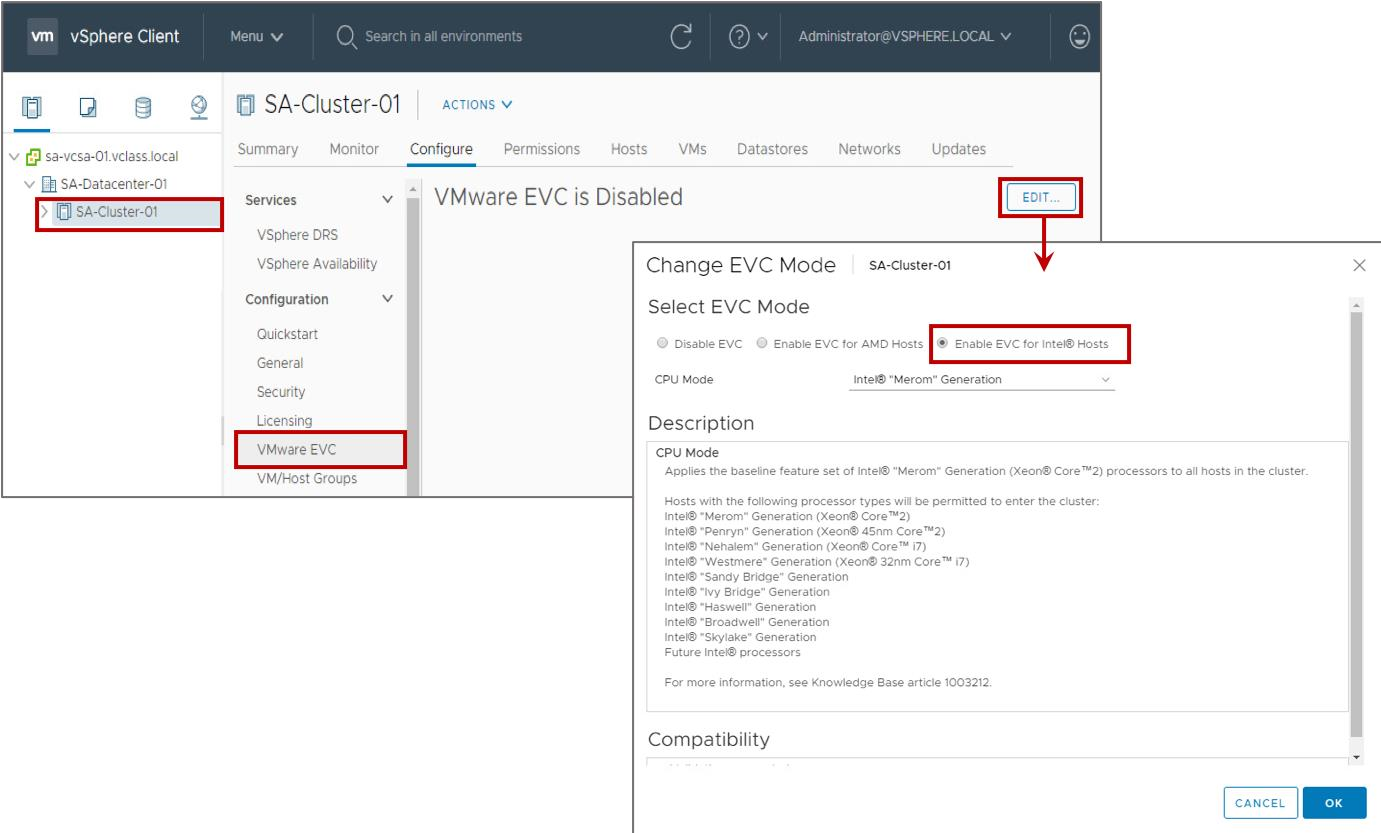
Enhanced vMotion Compatibility
Learner Objectives
After completing this lesson, you should be able to meet the following objectives:
- Describe Enhanced vMotion Compatibility
- Configure EVC mode on a vSphere cluster
- Explain how per-VM EVC mode works with vSphere vMotion
CPU Constraints on vSphere vMotion Migration
CPU compatibility between source and target hosts is a vSphere vMotion requirement that must be met.
| CPU Characteristics | Exact Match Required By Source Host and Target Host | Reason |
| Clock speeds, cache sizes, hyperthreading, and number of cores | N/A | The VMkernel virtualizes these characteristics. |
| Manufacturer (Intel or AMD) family and generation (Opteron4, Intel Westmere) | Applicable | Instruction sets contain many small differences. |
| Presence or absence of SSE3, SSSE3, or SSE4.1 instructions | Applicable | Multimedia instructions are usable directly by applications. |
| Virtualization hardware assist | For 32-bit VMs: N/A | The VMkernel virtualizes this characteristic. |
| For 64-bit VMs on Intel: Applicable | Intel 64-bit with VMware implementation uses Intel VT. |
About Enhanced vMotion Compatibility
Enhanced vMotion Compatibility is a cluster feature that prevents vSphere vMotion migrations from failing because of incompatible CPUs. This feature works at the cluster level, using CPU baselines to configure all processors in the cluster that are enabled for Enhanced vMotion Compatibility. 
Enhanced vMotion Compatibility Cluster Requirements
All hosts in the cluster must meet several requirements:
- Use CPUs from a single vendor, either Intel or AMD:
- Use Intel CPUs with Merom microarchitecture and later.
- Use AMD first-generation Opteron CPUs and later.
- Be enabled for hardware virtualization: AMD-V or Intel VT.
- Be enabled for execution-disable technology: AMD No eXecute (NX) or Intel eXecute Disable (XD).
- Be configured for vSphere vMotion migration.
Applications in VMs must be CPU ID compatible.
Enabling EVC Mode on an Existing Cluster
You enable EVC mode on an existing cluster to ensure vSphere vMotion CPU compatibility between the hosts in the cluster.

Changing the EVC Mode for a Cluster
Several EVC mode approaches are available to ensure CPU compatibility:
- If all the hosts in a cluster are compatible with a newer EVC mode, you can change the EVC mode of an existing Enhanced vMotion Compatibility cluster.
- You can enable EVC mode for a cluster that does not have EVC mode enabled.
You can raise or lower the EVC mode, but the VMs must be in the correct power state to do so.
| EVC Mode | VM Power Action |
| Raise the EVC mode to a CPU baseline with more features. |
|
| Lower the EVC mode to a CPU baseline with fewer features |
|
Virtual Machine EVC Mode
EVC mode can be applied to some or all VMs in a cluster:
- At the VM level, EVC mode facilitates the migration of VMs beyond the cluster and across vCenter Server systems and data centers.
- You can apply more granular definitions of Enhanced vMotion Compatibility for specific VMs.
- VM EVC mode is independent of the EVC mode defined at the cluster level.
- VM EVC mode requires vSphere 6.7 or later.

Review of Learner Objectives
After completing this Enhanced vMotion Compatibility lesson, you should be able to meet the following objectives:
- Describe Enhanced vMotion Compatibility
- Configure EVC mode on a vSphere cluster
- Explain how per-VM EVC mode works with vSphere vMotion